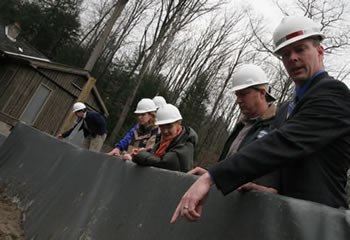FOR IMMEDIATE RELEASE06-14 March 14, 2006 Contact: Ian Michaels (718) 595-6600 Ashokan Release Channel to Open This WeekTesting to begin Wednesday with full operation possible by end of week
Commissioner Emily Lloyd of the New York City Department of Environmental Protection (DEP) today announced that the Ashokan Release Channel will be opened this week. With weather conditions permitting, the channel will be tested on Wednesday, March 15 and could be fully operational by the end of the week. “The DEP has gone through great effort to re-open the release channel in order to provide some relief to people living downstream,” said Commissioner Lloyd. “Water levels in the Ashokan Reservoir have been above normal since the record rainfall we received in October, and they’ll likely remain high throughout the spring. But with this step we will be able to make controlled releases from the reservoir to help protect property along the lower Esopus.” Water from the release channel flows through the Beaver Kill into the Old Esopus Creek, which flows through the SUNY New Paltz Ashokan Field Campus on its way to the lower Esopus Creek. The last time the channel was operated was in 1992. Once testing is complete and full flow is restored, up to 600 million gallons per day (MGD) of water will be able to flow through. The DEP has leased the entire Ashokan Field Campus through mid-June in order to re-open the channel. Significant improvement work, including the construction of berms and barriers, had to be performed in order to protect campus buildings from possible flooding and to accommodate the anticipated flows in the Old Esopus Creek. Even with those improvements, it is expected that part of the campus may be flooded. The only other controlled method for water to exit the Ashokan Reservoir is through the Catskill Aqueduct, which conveys drinking water to users south of Ulster County. The DEP has increased its intake through the aqueduct from a normal flow of 300 - 350 million gallons per day (MGD) to the aqueduct’s maximum capacity of 580 MGD. However, flow into the reservoir has often exceeded that amount and the reservoir has largely been above capacity and spilling into the lower Esopus since October, when the region received over 12 inches of rain. The high water conditions at Ashokan have been affected by the need to remove water from the Schoharie Reservoir in order to accomplish the ongoing stabilization project at the Gilboa Dam. Water from Schoharie is diverted through the Shandaken Tunnel, which outlets into the upper Esopus Creek. The release channel would be operated when water levels in the lower Esopus were below flood stage, with the intent of creating a void in the reservoir to capture flow from the Shandaken Tunnel as well as the anticipated annual runoff from the coming spring thaw. The DEP has created detailed parameters for channel operations based on variables such as weather and water elevations within the lower Esopus. Testing of the channel will include monitoring the effect of water flow at numerous locations along the path of the water. A small flow of approximately 100 MGD will be used Wednesday to test the integrity of the channel. A flow of up to 400 MGD is expected by Thursday, with higher flows being gradually implemented through the end of the week.
| ||||
